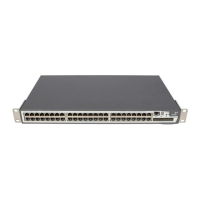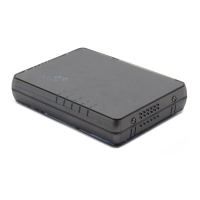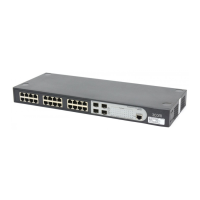OSPF Configuration Commands 205
For all the routers connected to the NSSA area, the command nssa must be used
to configure the area as the NSSA attribute.
The default-route-advertise parameter is used to generate a default type-7
LSA. No matter whether there is route 0.0.0.0 in the routing table on an ABR,
type-7 LSA default route will always be generated. Only when there is route
0.0.0.0 in routing table on ASBR, will a type-7 LSA default route be generated.
On ASBR, the no-import-route parameter disables an external route that is
imported by OSPF with the
import-route command from being advertised to the
NSSA area.
Example
To configure area 1as an NSSA area, enter the following:
<SW5500>system-view
System View: return to User View with Ctrl+Z.
[SW5500]router id 1.1.1.1
[SW5500]ospf
[SW5500-ospf-1]area 1
[SW5500-ospf-1-area-0.0.0.1]network 36.0.0.0 0.255.255.255
[SW5500-ospf-1-area-0.0.0.1]nssa
ospf Syntax
ospf [
process-id
[ router-id
router-id
]]
undo ospf
View
System View
Parameter
process-id
Enter the ID of the OSPF process, ranging from 1 to 65535. By
default, the process ID is 1.
process-id
is locally significant.
router-id
Enter the router ID that is a 32-bit unsigned integer.
Description
Using the ospf command, you can enable the OSPF protocol.
Using the undo ospf command, you can disable the OSPF protocol. By default, the
system does not run the OSPF protocol.
After enabling the OSPF protocol, you can configure OSPF operations using the
commands described in the “OSPF Configuration Commands” section.
Related command: network.
Example
Enable the OSPF protocol.
<SW5500>system-view
System View: return to User View with Ctrl+Z.
[SW5500]router id 1.1.1.1

